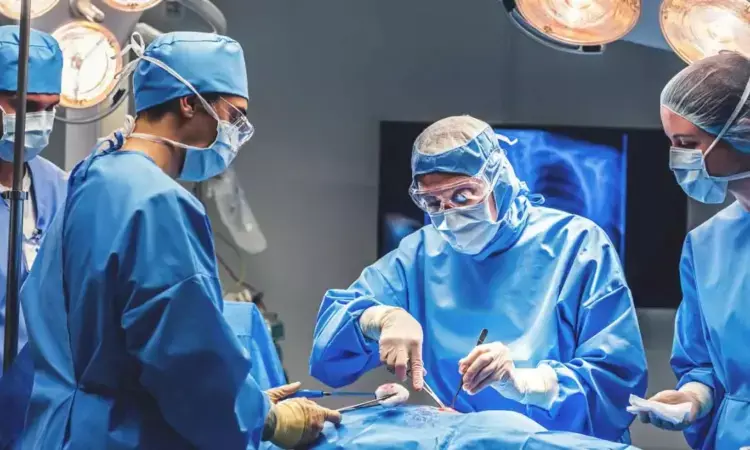- Home
- Medical news & Guidelines
- Anesthesiology
- Cardiology and CTVS
- Critical Care
- Dentistry
- Dermatology
- Diabetes and Endocrinology
- ENT
- Gastroenterology
- Medicine
- Nephrology
- Neurology
- Obstretics-Gynaecology
- Oncology
- Ophthalmology
- Orthopaedics
- Pediatrics-Neonatology
- Psychiatry
- Pulmonology
- Radiology
- Surgery
- Urology
- Laboratory Medicine
- Diet
- Nursing
- Paramedical
- Physiotherapy
- Health news
- Fact Check
- Bone Health Fact Check
- Brain Health Fact Check
- Cancer Related Fact Check
- Child Care Fact Check
- Dental and oral health fact check
- Diabetes and metabolic health fact check
- Diet and Nutrition Fact Check
- Eye and ENT Care Fact Check
- Fitness fact check
- Gut health fact check
- Heart health fact check
- Kidney health fact check
- Medical education fact check
- Men's health fact check
- Respiratory fact check
- Skin and hair care fact check
- Vaccine and Immunization fact check
- Women's health fact check
- AYUSH
- State News
- Andaman and Nicobar Islands
- Andhra Pradesh
- Arunachal Pradesh
- Assam
- Bihar
- Chandigarh
- Chattisgarh
- Dadra and Nagar Haveli
- Daman and Diu
- Delhi
- Goa
- Gujarat
- Haryana
- Himachal Pradesh
- Jammu & Kashmir
- Jharkhand
- Karnataka
- Kerala
- Ladakh
- Lakshadweep
- Madhya Pradesh
- Maharashtra
- Manipur
- Meghalaya
- Mizoram
- Nagaland
- Odisha
- Puducherry
- Punjab
- Rajasthan
- Sikkim
- Tamil Nadu
- Telangana
- Tripura
- Uttar Pradesh
- Uttrakhand
- West Bengal
- Medical Education
- Industry
Total hip arthroplasty: Direct anterior approach in the supine position provides more accurate component positions

China: A recent study published in BMC Musculoskeletal Disorders has shown fluoroscopy-guided direct anterior approach (DAA) in the supine position to be advantageous in total hip replacement.
The retrospective analysis of 76 total hip arthroplasty cases compared the fluoroscopy-guided direct anterior approach in the supine position (S-DAA) with the lateral decubitus position (L-DAA). Results suggested that in the supine group, the DAA provided more accurate positioning of the femoral and acetabular components. However, the study showed no significant difference between the two groups at follow-up in hip joint function and activity.
Total hip arthroplasty (THA) is one of the most reliable and successful orthopaedic procedures, and there is a continuous increase in the demand for THA given its success and improved quality of life for patients, where the accurate placement of the acetabular component is both difficult and important to achieve.
Accurate positioning of the acetabular component in THA can reduce the occurrence of postoperative complications, such as slowing the wear of the polyethene liner, increasing the stability of the hip joint, reducing the risk of prosthesis loosening and the difference in bilateral leg length. This implies the importance of the position of femoral and acetabular components for wear resistance and stability.
Weifeng Ji, The First Affiliated Hospital of Zhejiang Chinese Medical University, Hangzhou, Zhejiang Province, China, and colleagues set out to determine whether the fluoroscopy-guided direct anterior approach in the supine position is more helpful in improving the position of femoral and acetabular components than the fluoroscopy-guided direct anterior approach in the lateral decubitus position.
For this purpose, the researchers performed a retrospective analysis of 76 cases of fluoroscopy-guided DAA total hip arthroplasty (38 cases in the S-DAA and 38 cases in the L-DAA group) in one hospital from 2019 to 2021. They analyzed differences in anteversion, inclination, global offset (GO), femoral offset (FO), and leg length discrepancy (LLD) measurements during and after surgery. The postoperative FO, GO, LLD, and postoperative and preoperative Harris hip scores were compared between the groups.
The researchers reported the following findings:
· In the S-DAA group, there were no significant differences in the mean intraoperative inclination angle anteversion angle, FO, GO, and LLD compared to the postoperative values,
· In the L-DAA group, there were significant differences between the intraoperative and postoperative measurements.
· There were significant differences in the accuracy of LLD, FO, and GO between the two groups.
· Compared with the L-DAA group, the average differences of inclination, anteversion, LLD, FO, and GO during and after operation in the S-DAA group were smaller, and the consistency was higher.
· There was a significant difference in Harris hip score between the two groups one week after surgery.
· There was no significant difference in Harris hip score between 1 month and three months after surgery.
"The findings showed DAA in the supine position to be more accurate for positioning the prosthesis than the DAA in the lateral position under fluoroscopy," the researchers wrote.
"In the follow-up, we found no significant difference in the range of motion and function of the hip joint, and the quality of life improved in both patients in the lateral position and patients in the supine position after total hip arthroplasty with DAA.
Reference:
Chen, P., Liu, W., Wu, C. et al. Fluoroscopy-guided direct anterior approach total hip arthroplasty provides more accurate component positions in the supine position than in the lateral position. BMC Musculoskelet Disord 24, 884 (2023). https://doi.org/10.1186/s12891-023-07014-4
Dr Kamal Kant Kohli-MBBS, DTCD- a chest specialist with more than 30 years of practice and a flair for writing clinical articles, Dr Kamal Kant Kohli joined Medical Dialogues as a Chief Editor of Medical News. Besides writing articles, as an editor, he proofreads and verifies all the medical content published on Medical Dialogues including those coming from journals, studies,medical conferences,guidelines etc. Email: drkohli@medicaldialogues.in. Contact no. 011-43720751


